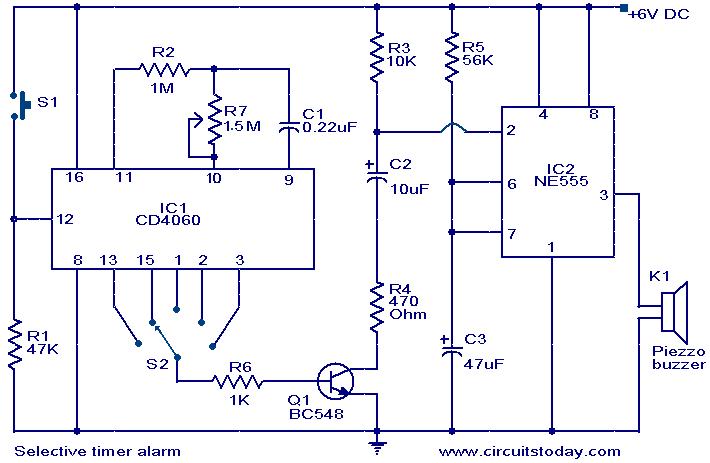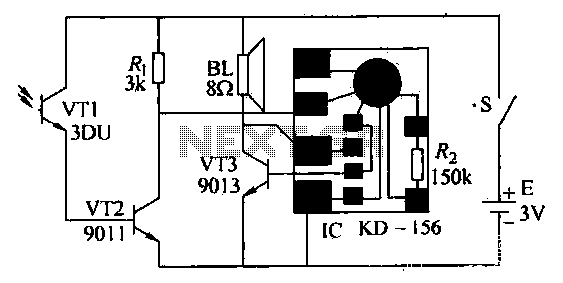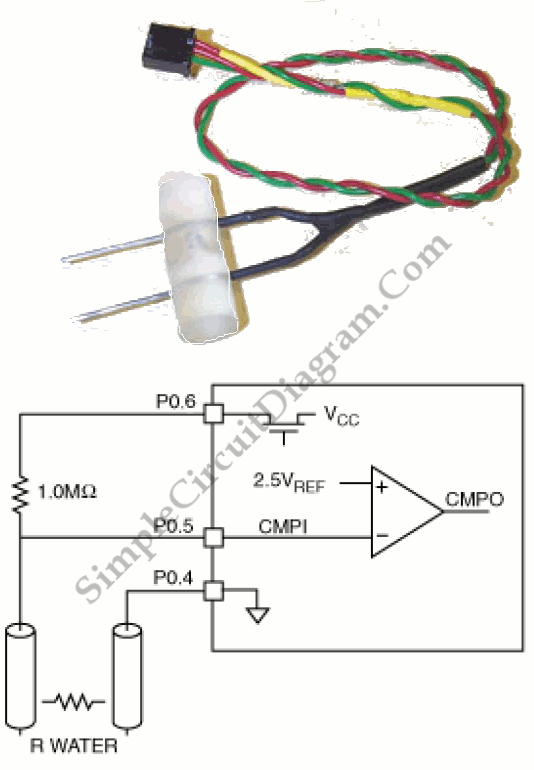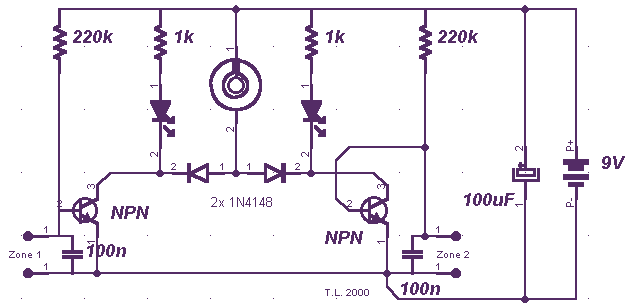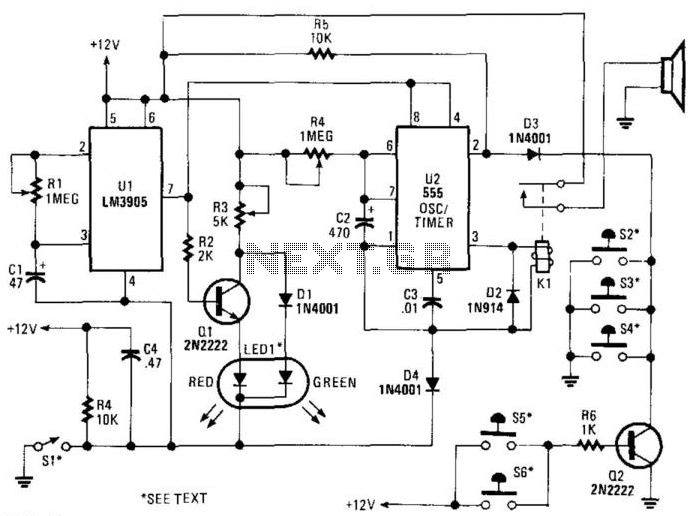
garageshed alarm
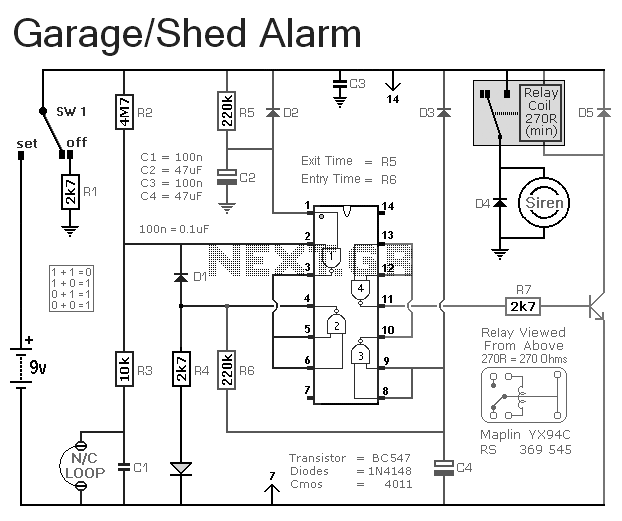
This is a simple single-zone burglar alarm circuit. Its features include automatic exit and entry delays. It is designed to be used with commonly available normally-closed input devices such as magnetic reed contacts, micro switches, foil tape, and passive infrared sensors (PIRs). The circuit has an extremely low standby current, making it suitable for battery-powered operation. A 9-volt battery is depicted in the diagram, but the circuit can function with voltages ranging from 5 to 15 volts. It is essential to select a relay and siren that are compatible with the chosen voltage. The operation of the alarm is straightforward. To activate the alarm, switch SW1 to the "set" position. This action allows approximately 10 to 15 seconds to exit the premises. Upon returning and opening the door, the green LED will illuminate, providing another 10 to 15 seconds to move SW1 to the "off" position. If the switch is not turned off within this time frame, the relay will activate, triggering the siren. The siren can be deactivated at any moment by moving SW1 to the "off" position. Due to manufacturing tolerances, the exact duration of any delay may vary based on the specific components used in the circuit. However, the exit and entry delays can be adjusted by changing the values of resistors R5 and R6; increasing these values will extend the delay time, while decreasing them will shorten it.
The burglar alarm circuit operates on a straightforward principle, utilizing a combination of resistive and capacitive components to create a timing mechanism that governs the exit and entry delays. The circuit is typically built around a timer IC, such as the 555 timer, configured in monostable mode to generate the necessary delay intervals.
The input devices, which may include magnetic reed switches or PIR sensors, are connected to the input of the timer circuit. When the system is armed, the closure of these contacts initiates the timing cycle. The timer's output can drive a relay, which in turn activates the siren when the alarm conditions are met. A green LED serves as a visual indicator, confirming the system's armed status and signaling the user during the entry delay.
The choice of resistors R5 and R6 is critical for tailoring the timing intervals. These resistors, in combination with a capacitor, define the charge and discharge times, thus controlling how long the user has to exit or enter the premises without triggering the alarm. The circuit's design allows for flexibility in component selection, ensuring compatibility with various input devices and power supply voltages, while maintaining low power consumption for extended battery life.
Overall, this burglar alarm circuit offers a simple yet effective solution for enhancing security in residential or commercial settings, with customizable features to meet specific user needs.This is a simple single-zone burglar alarm circuit. Its features include automatic Exit and Entry delays. It`s designed to be used with the usual types of normally-closed input devices such as - magnetic-reed contacts - micro switches - foil tape - and PIRs. It has an extremely small standby current - making it ideal for battery-powered operation. I`ve used a 9-volt battery in the diagram - but the circuit will work at anything from 5 to 15-volts. Just choose a relay and Siren suitable for the voltage you want to use. It`s easy to use. To set the alarm move SW1 to the "set" position. You now have about 10 to 15 seconds to leave the building. When you return and open the door - the green LED will light. You then have about 10 to 15 seconds to move SW1 to the "off" position. If you fail to do so - the relay will energize and the Siren will sound. Of course - you can turn the Siren off at any time by moving SW1 to the "off" position. Because of manufacturing tolerances - the precise length of any delay depends on the characteristics of the actual components you`ve used in your circuit.
But by altering the values of R5 & R6 you can adjust the Exit and Entry times to suit your requirements. Increasing the values increases the time - and vice-versa. 🔗 External reference
The burglar alarm circuit operates on a straightforward principle, utilizing a combination of resistive and capacitive components to create a timing mechanism that governs the exit and entry delays. The circuit is typically built around a timer IC, such as the 555 timer, configured in monostable mode to generate the necessary delay intervals.
The input devices, which may include magnetic reed switches or PIR sensors, are connected to the input of the timer circuit. When the system is armed, the closure of these contacts initiates the timing cycle. The timer's output can drive a relay, which in turn activates the siren when the alarm conditions are met. A green LED serves as a visual indicator, confirming the system's armed status and signaling the user during the entry delay.
The choice of resistors R5 and R6 is critical for tailoring the timing intervals. These resistors, in combination with a capacitor, define the charge and discharge times, thus controlling how long the user has to exit or enter the premises without triggering the alarm. The circuit's design allows for flexibility in component selection, ensuring compatibility with various input devices and power supply voltages, while maintaining low power consumption for extended battery life.
Overall, this burglar alarm circuit offers a simple yet effective solution for enhancing security in residential or commercial settings, with customizable features to meet specific user needs.This is a simple single-zone burglar alarm circuit. Its features include automatic Exit and Entry delays. It`s designed to be used with the usual types of normally-closed input devices such as - magnetic-reed contacts - micro switches - foil tape - and PIRs. It has an extremely small standby current - making it ideal for battery-powered operation. I`ve used a 9-volt battery in the diagram - but the circuit will work at anything from 5 to 15-volts. Just choose a relay and Siren suitable for the voltage you want to use. It`s easy to use. To set the alarm move SW1 to the "set" position. You now have about 10 to 15 seconds to leave the building. When you return and open the door - the green LED will light. You then have about 10 to 15 seconds to move SW1 to the "off" position. If you fail to do so - the relay will energize and the Siren will sound. Of course - you can turn the Siren off at any time by moving SW1 to the "off" position. Because of manufacturing tolerances - the precise length of any delay depends on the characteristics of the actual components you`ve used in your circuit.
But by altering the values of R5 & R6 you can adjust the Exit and Entry times to suit your requirements. Increasing the values increases the time - and vice-versa. 🔗 External reference
